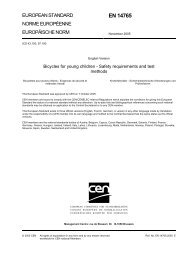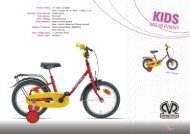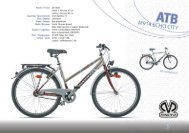EN 14766:2005 - 64_e_stf - Baltik vairas
EN 14766:2005 - 64_e_stf - Baltik vairas
EN 14766:2005 - 64_e_stf - Baltik vairas
- No tags were found...
You also want an ePaper? Increase the reach of your titles
YUMPU automatically turns print PDFs into web optimized ePapers that Google loves.
<strong>EN</strong> <strong>14766</strong>:<strong>2005</strong> (E)Annex A(informative)Explanation of the method of least squares for obtaining line of best fitand ± 20 % limit lines for braking performance linearityThe readings taken in the test specified in 4.6.7.5.2.8 can be expected to lie near some straight line that can bedrawn through them. Although in practice one might draw a good straight line through the points by eye, themethod of least squares given here provides a criterion for minimising the discrepancies, and permits a line to beselected that has a claim to be called the best fit.The line of best fit is the line that minimises the sum of the squares of the differences between the observed resultsand the corresponding results predicted by the line.The relationship between the variables is considered to be of the form:y = a + bxwherexyis the independent variable, and is known precisely (in this case the load applied to the pedal);is the dependent variable, and is observed but with a degree of uncertainty (in this case, the brakingforce at the wheel).a and b are unknown constants and have to be estimated.For a series of n readings, this relationship can be resolved by taking a minimum of the sum of the squares of thedifference to give:Taking:nb =n∑∑xy −x2−∑x∑∑x∑yx∑y y= and∑x x=nnb =∑∑xy − yx2− x∑∑xxThen a may be found by substitution:a = y − bxEXAMPLEThe following four values of x and y are noted during a test, from which84







